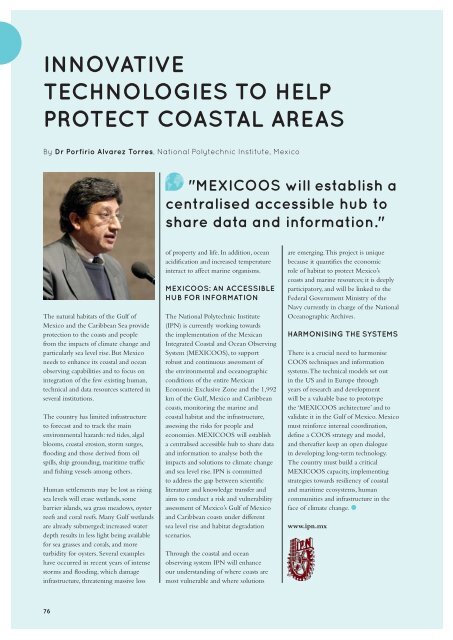Climate Action 2014-2015
Create successful ePaper yourself
Turn your PDF publications into a flip-book with our unique Google optimized e-Paper software.
INNOVATIVE<br />
TECHNOLOGIES TO HELP<br />
PROTECT COASTAL AREAS<br />
By Dr Porfirio Alvarez Torres, National Polytechnic Institute, Mexico<br />
"MEXICOOS will establish a<br />
centralised accessible hub to<br />
share data and information."<br />
The natural habitats of the Gulf of<br />
Mexico and the Caribbean Sea provide<br />
protection to the coasts and people<br />
from the impacts of climate change and<br />
particularly sea level rise. But Mexico<br />
needs to enhance its coastal and ocean<br />
observing capabilities and to focus on<br />
integration of the few existing human,<br />
technical and data resources scattered in<br />
several institutions.<br />
The country has limited infrastructure<br />
to forecast and to track the main<br />
environmental hazards: red tides, algal<br />
blooms, coastal erosion, storm surges,<br />
flooding and those derived from oil<br />
spills, ship grounding, maritime traffic<br />
and fishing vessels among others.<br />
Human settlements may be lost as rising<br />
sea levels will erase wetlands, some<br />
barrier islands, sea grass meadows, oyster<br />
reefs and coral reefs. Many Gulf wetlands<br />
are already submerged; increased water<br />
depth results in less light being available<br />
for sea grasses and corals, and more<br />
turbidity for oysters. Several examples<br />
have occurred in recent years of intense<br />
storms and flooding, which damage<br />
infrastructure, threatening massive loss<br />
of property and life. In addition, ocean<br />
acidification and increased temperature<br />
interact to affect marine organisms.<br />
MEXICOOS: AN ACCESSIBLE<br />
HUB FOR INFORMATION<br />
The National Polytechnic Institute<br />
(IPN) is currently working towards<br />
the implementation of the Mexican<br />
Integrated Coastal and Ocean Observing<br />
System (MEXICOOS), to support<br />
robust and continuous assessment of<br />
the environmental and oceanographic<br />
conditions of the entire Mexican<br />
Economic Exclusive Zone and the 1,992<br />
km of the Gulf, Mexico and Caribbean<br />
coasts, monitoring the marine and<br />
coastal habitat and the infrastructure,<br />
assessing the risks for people and<br />
economies. MEXICOOS will establish<br />
a centralised accessible hub to share data<br />
and information to analyse both the<br />
impacts and solutions to climate change<br />
and sea level rise. IPN is committed<br />
to address the gap between scientific<br />
literature and knowledge transfer and<br />
aims to conduct a risk and vulnerability<br />
assessment of Mexico’s Gulf of Mexico<br />
and Caribbean coasts under different<br />
sea level rise and habitat degradation<br />
scenarios.<br />
Through the coastal and ocean<br />
observing system IPN will enhance<br />
our understanding of where coasts are<br />
most vulnerable and where solutions<br />
are emerging. This project is unique<br />
because it quantifies the economic<br />
role of habitat to protect Mexico’s<br />
coasts and marine resources; it is deeply<br />
participatory, and will be linked to the<br />
Federal Government Ministry of the<br />
Navy currently in charge of the National<br />
Oceanographic Archives.<br />
HARMONISING THE SYSTEMS<br />
There is a crucial need to harmonise<br />
COOS techniques and information<br />
systems. The technical models set out<br />
in the US and in Europe through<br />
years of research and development<br />
will be a valuable base to prototype<br />
the ‘MEXICOOS architecture’ and to<br />
validate it in the Gulf of Mexico. Mexico<br />
must reinforce internal coordination,<br />
define a COOS strategy and model,<br />
and thereafter keep an open dialogue<br />
in developing long-term technology.<br />
The country must build a critical<br />
MEXICOOS capacity, implementing<br />
strategies towards resiliency of coastal<br />
and maritime ecosystems, human<br />
communities and infrastructure in the<br />
face of climate change. <br />
www.ipn.mx<br />
76












